The Role of Cytotoxic Chemotherapy in Prostate Cancer
In this review, we describe how clinical investigators addressed some of the challenges in prostate cancer chemotherapy trials 20 years ago, and we indicate what has evolved in the field since that time. We consider the impact that prostate-specific antigen measurement had in this setting, evolving clinical paradigms, multidisciplinary programs, and the current armamentarium of cancer treatment, including targeted molecular therapy, for patients with hormone-refractory disease.
In this review, we describe how clinical investigators addressed some of the challenges in prostate cancer chemotherapy trials 20 years ago, and we indicate what has evolved in the field since that time. We consider the impact that prostate-specific antigen measurement had in this setting, evolving clinical paradigms, multidisciplinary programs, and the current armamentarium of cancer treatment, including targeted molecular therapy, for patients with hormone-refractory disease.
Approximately 20 years ago, the lead author of this paper co-wrote an extensive paper on the experience with cytotoxic chemotherapy in prostate cancer.[1] Frequently cited in subsequent publications on the subject, this comprehensive review of the literature served as the basis for discussing this treatment modality at the first National Institutes of Health consensus conference on prostate cancer in 1987. While the paper reflected state-of-the-art knowledge about nonhormonal treatment approaches, the natural history of prostate cancer was only beginning to undergo systematic study. Disease-oriented research programs were first being organized, and data on outcomes relied primarily on long-term experience from a few large-scale clinical trials. The importance of clinical trial methodology was just beginning to be emphasized. The selection of endpoints to determine therapeutic efficacy was frequently based on semi-intuitively derived, and often biased, observations that were never properly validated.
The original publication discussed the methodologic challenges involving clinical trials in prostate cancer, and placed the issue in perspective. A unique aspect of that review was its emphasis on survival analyses in phase III trials as the endpoint for conclusively defining efficacy. The paper stressed the lack of evidence to support routine use of any treatment regimen based on survival observations from randomized studies in patients with hormone-resistant prostate cancer (HRPC). Perhaps most critically, in 1987, prostate-specific antigen (PSA) was only a "promising marker" awaiting clinical application.
Twenty Years Later
In the current review, we indicate what has evolved since that report from 20 years ago. We will consider the current status of nonhormonal chemotherapy for patients with hormone-refractory disease and provide a more global view of the clinical paradigms for which chemotherapy may be developed. The current armamentarium of cancer treatment includes a rapidly growing class of compounds-generally classified as noncytotoxic treatments-designed to target specific biologic mechanisms that control the growth of cancer at the molecular level. These agents differ substantially from the empiric cytotoxic chemotherapy that represented the only approach available 20 years ago.
The clinical development of noncytotoxic treatment requires a completely different methodology from that employed for the development of conventional cytotoxics. Today, this methodology is the focus of extensive study, not only in prostate cancer, but in other malignancies as well. It is becoming increasingly clear that the development of new treatments requires the identification of clinical paradigms and endpoints that are specific for the treatment modality being tested. For example, the most adequate paradigm for developing bone-targeted approaches may differ substantially from the approach taken with immunotherapies or antimetastatic compounds designed to interfere with the process of metastasis at earlier stages of the disease.
In this review, we will describe how we addressed some of the challenges posed to clinical investigators 20 years ago and what has been accomplished since that time. In addition, we will outline the new challenges facing us.
Historical Perspective
HRPC in the Pre-PSA Era
Until 1987, chemotherapy trials in prostate cancer were largely limited to patients with evidence of radiologic and/or symptomatic disease progression after conventional androgen suppression. Results of different clinical trials were difficult to compare in view of the variability in eligibility criteria and criteria employed to define therapeutic benefit. The hormone-refractory patient population of the pre-PSA era was commonly characterized by patients with extensive disease involvement, frequent incidence of significant symptoms such as pain, anemia, and reduced functional status, and a history of extensive prior palliative radiation therapy. In such patients, tolerance to conventional cytotoxic treatments is often reduced, frequently requiring attenuation of doses of myelotoxic agents, which constituted the majority of regimens available at that time.
In the extensive 1985 review, we emphasized a number of issues. First, response rates reported in phase II trials with most regimens were generally low. Clearly, in most cases, clinical responses did not represent convincing evidence to support therapeutic efficacy. A common argument was that evidence of tumor shrinkage-a commonly relied upon parameter-could not be reliably assessed in most patients with metastatic prostate cancer because of the pattern of metastasis in this disease (ie, osteoblastic bone metastasis). Because of the infrequent incidence of bidimensionally measurable disease, various groups employed a "new" category-stable disease. This response category was popularized by a clinical trials group known as the National Prostate Cancer Project (NPCP), which was the most active National Cancer Institute-funded clinical trials group in prostate cancer at that time.
Studies conducted by the NPCP reflected a sequence of relatively small randomized phase II trials with various chemotherapeutic regimens utilized during the 1970s and early 1980s. NPCP investigators defined stable disease as "no evidence of disease progression for 12 weeks."[2] This was based on the observation that patients without progression at 12 weeks from the start of the trial had a longer survival than those showing progression by that time. This highly biased and unvalidated criterion was vigorously disseminated and employed in clinical trials for several years and, extraordinarily, it was employed as a key criterion in the US Food and Drug Administration (FDA) approval of estramustine phosphate (Emcyt), the first chemotherapeutic compound approved for prostate cancer in the United States.

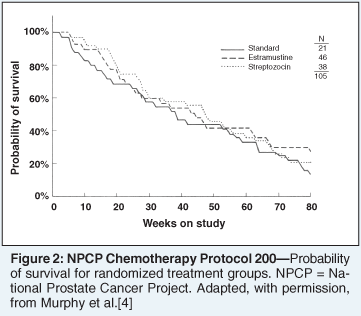
The first two NPCP studies (study 100 and 200, Figures 1 and 2), conducted in two different patient populations based on extent of prior radiation, compared various regimens against a control arm designated as "standard treatment." Patients in the control arm received a variety of palliative therapies, including radiation for pain control, analgesics, and alternative hormonal approaches such as corticosteroids.[3,4] NPCP 100 compared weekly fluorouracil vs cyclophosphamide vs standard treatment, whereas NPCP 200 compared estramustine phosphate vs streptozotocin (streptozocin, Zanosar) vs standard treatment.
The results of these two studies indicated very similar median survivals in all treatment arms, despite the higher "response" rates reported with the chemotherapy regimens, most of which were in the "stable disease" category. In both studies, crossover from standard treatment to chemotherapy arms was permissible. Given the advanced stage of these patients at the time of crossover, and based on the infrequent "responses" reported with treatment in those initially assigned to the chemotherapy arms, it is unlikely that crossover treatment resulted in any meaningful benefit that would affect survival.
These results served as the foundation for testing other regimens without further comparisons to a "no chemotherapy" control arm. Additional regimens evaluated on NPCP studies included dacarbazine, procarbazine (Matulane), prednimustine (Sterecyt), semustine (methyl-CCNU), vincristine, methotrexate, cisplatin, hydroxyurea, and combinations thereof. Besides their historical value, these trials provided no evidence to support the routine use of any of these regimens for the treatment of patients with hormone-refractory prostate cancer.
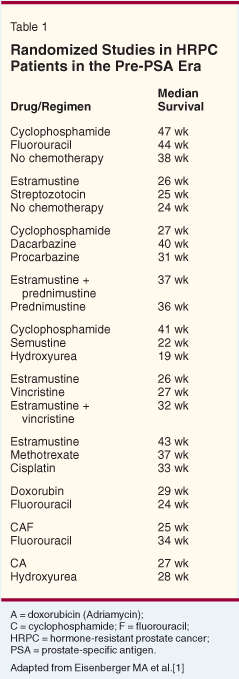
Table 1 illustrates the results of prospectively randomized studies conducted by the NPCP and other investigators before 1987. Figure 3 represents a composite figure for all prospectively randomized studies containing 20 or more patients per arm.[1] After its original publication in 1985, this figure became known as the "spaghetti curve."
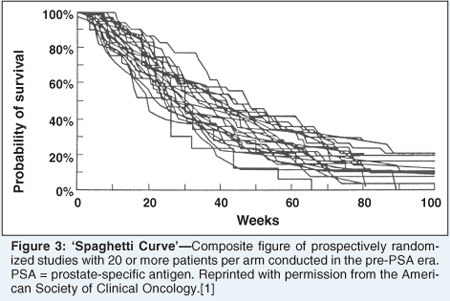
HRPC in the PSA Era
The introduction of the serum PSA test in routine clinical practice had a remarkable impact on virtually all aspects of the disease. In the clinical trials area, it changed the clinical definition of hormone-refractory disease, resulted in a decisive shift toward earlier identification of disease progression following androgen deprivation, and as a result of the lead-time effect, it changed the survival figures of the HRPC paradigm, nearly doubling them. It also changed the pattern of clinical characteristics of patients entering HRPC trials-from the painful, anemic, functionally impaired, and extensively pretreated patient to the frequently asymptomatic and generally healthier patient.
In fact, in a recent pivotal trial (TAX 327) that resulted in the FDA approval of docetaxel for HRPC, less than 50% of the patients had significant pain, the median functional status was 90% in the Karnofsky scale, and the vast majority of patients had adequate hemoglobin levels.[5] All of these factors, in addition to the extent of metastatic disease, have consistently been shown to be independent predictors of survival in Cox hazard models reported by different investigators. Median survival in the control arm of TAX 327, which included a primarily palliative regimen (mitoxantrone [Novantrone] plus prednisone) without prior demonstrable survival benefit, was 16.5 months. In comparison, the median survival in the control arms of NPCP studies 100 and 200 ranged from 6 to 9.5 months (Table 1).
Preliminary observations derived from a prospective randomized study in patients with stage D2 disease with bone involvement who demonstrated evidence of disease progression on a combined androgen deprivation approach are similarly instructive (Table 2). These results further illustrate how wide the range in survival of the HRPC patient can be if one evaluates the type of progression (PSA progression only vs PSA plus bone scan progression) in patients with various degrees of bone scan involvement (extensive vs limited). Survival figures range from 11 months in patients with extensive bone scan involvement who demonstrated a rising serum PSA (> 4.0 µg/mL) and bone scan progression, to 40 months in patients with limited bone scan involvement who demonstrated evidence of PSA progression (> 4.0 µg/mL) alone (no bone scan progression).

• Serial PSA Measurement-Routine utilization of serial measurements of serum PSA levels as a tool to evaluate therapeutic benefit has modified the landscape of response rates in HRPC, despite the significant controversy that remains as to what level of decline reflects therapeutic benefit. The literature discussing the significance of serial PSA measurements in HRPC clinical trials is extensive. At this time, the general consensus is that while declines associated with treatment may represent a benefit, the precise nature of this contribution remains undefined.
A PSA consensus group offered preliminary guidelines aimed at developing uniform criteria for eligibility and response reporting in HRPC clinical trials.[7] Their preliminary report, however, was limited by the absence of a clear-cut demonstration of the relationship between PSA declines and more conventional clinical trial endpoints such as palliative outcomes and survival. Recent data from two large randomized studies[5,6] have provided conflicting results regarding the association between PSA declines measured at different times and survival.[8,9] Another recent preliminary report indicated a possible association between palliative endpoints and survival.[10] All of these observations should be considered hypothesis-generating, with the need for proper prospective validation in well designed prospectively randomized clinical trials. At the present time, prosectively randomized clinical trials in HRPC should be designed employing survival as the main study endpoint.
• Alternative Endpoints-Quality-of-life endpoints such as pain or the quantitative evaluation of symptoms have been employed as alternatives to more conventional criteria such as overall or progression-free-survival. For example, FDA approval of the combination of mitoxantrone plus prednisone-the second regimen approved for patients with HRPC-was based on improvements in pain control compared to prednisone alone (Table 3).[11] The combination had no relative impact on disease progression or survival.
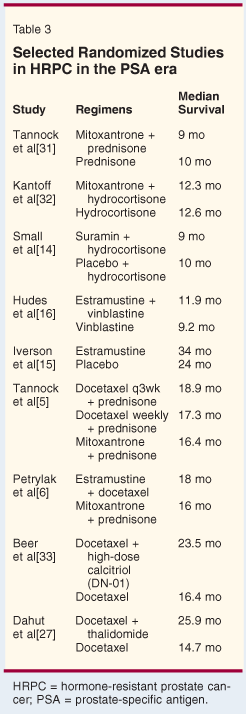
• Suramin-Another compound that generated a great deal of initial enthusiasm in early phase I and II trials was suramin, a polysulfonated naphtylurea that inhibits binding
of various autocrine growth factors
to their cellular receptors.[12,13] Suramin has complex pharmacologic properties (eg, a long terminal half-life) and an unusual toxicity pattern (eg, neural and renal toxicity, and tight protein-binding with slow release, producing malaise, fatigue, and anorexia). The pivotal phase III study used palliative end points in patients with symptomatic, end-stage HRPC. Outcomes with suramin were only modesty better than those with corticosteroids alone, and consequently, the drug has not been recommended for approval by the FDA.[14] Current drugs specifically targeting growth factors are safer than suramin.
• Estramustine-Estramustine phosphate is a nitrogen mustard derivative of estradiol-17-beta-phosphate that has demonstrated limited single-agent activity in prostate cancer. In a prospective randomized study in patients with hormone-refractory disease, estramustine phosphate given in a dose of 560 mg/d orally was not shown to be superior to placebo, in terms of palliative effects or survival (Table 3).[15] Preclinical data indicate that estramustine exerts its cytotoxic activity through microtubular inhibition[16] and binding to nuclear matrix.[17] Preclinical experience with estramustine also suggested significant synergy with other drugs, with effects at the level of the microtubule similar to those produced by vinblastine, docetaxel, and paclitaxel. Randomized comparisons between combinations of estramustine with other microtubule inhibitors, such as vinblastine[16] and docetaxel,[6] do not suggest a major contribution of this compound to regimens designed to target the microtubule (Table 3).
• Docetaxel-A semisynthetic cytotoxic member of the taxoid family, docetaxel induces apoptosis through p53-independent mechanisms due to inhibition of microtubule depolymerization and inhibition of antiapoptotic signaling. The induction of microtubule stabilization causes GTP-independent polymerization and cell-cycle arrest at G2M.
Docetaxel is the third FDA-approved compound for HRPC, based on a large phase III randomized trial that demonstrated a significant survival advantage over mitoxantrone and prednisone (Table 3).[5] At a median 20.7-month follow-up, the median survival in the every-3-week docetaxel arm was 18.9 months, compared with 17.3 months for weekly docetaxel and 16.4 months for mitoxantrone/prednisone. This translated into a 24% relative risk reduction in death (95% confidence interval [CI] = 6%-48%, P = .0005) with every-3-week docetaxel (Figure 4). Toxicity in the every-3-week arm was primarily hematologic. Quality of life, as measured by the Functional Assessment of Cancer Therapy-Prostate (FACT-P), was similar on the two docetaxel schedules, both of which produced superior scores to those seen on the mitoxantrone arm. While only the every-3-week docetaxel study was significantly better than mitoxantrone plus prednisone, this study was not designed to compare the two docetaxel regimens.[5]
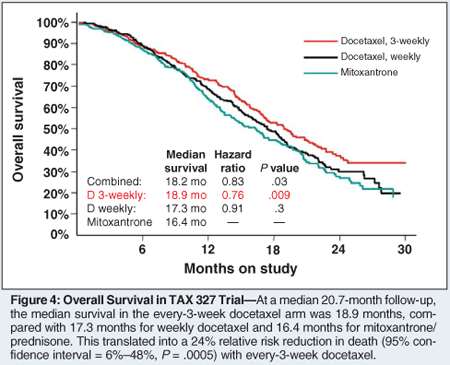
SWOG 9916 was the second large phase III trial in this setting,[6] with 770 HRPC patients randomly assigned to oral estramustine with docetaxel every 21 days or mitoxantrone/prednisone. Due to a high rate of cardiovascular thromboembolic events, prophylactic low-dose coumadin and aspirin were added to the estramustine arm, but these measures did not reduce the incidence of thromboembolism. The median survival on estramustine plus docetaxel was 18 months, compared to 16 months on mitoxantrone plus prednisone.
While comparisons across trials (ie, TAX 327 vs SWOG 9916) are not appropriate for definitive conclusions, due to differences in schedules, patient populations, and docetaxel dosing (60 mg/m2 in SWOG 9916 and 75 mg/m2 in TAX 327), it is reasonable to conclude that estramustine is unlikely to contribute significantly to the activity observed with single-agent docetaxel. Single-agent docetaxel given at 21-day intervals constitutes the current reference regimen for patients with HRPC. The HRPC landscape of 2006 is illustrated in Figure 5.
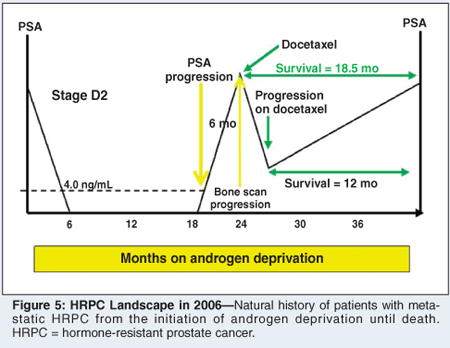
The Nonmetastatic Paradigm
As indicated above, the PSA era has introduced new paradigms in clinical practice. Undoubtedly the most challenging group of patients to reflect these changes are those who present, after local treatment, with rising levels of serum PSA as the only evidence of disease activity. Despite the fact that the appropriate management of these patients remains undefined, most will be initiated on androgen deprivation before metastatic disease becomes evident.
The natural history of these patients has only recently been described. The first such publication, by Pound and colleagues from the Johns Hopkins University,[18] describes the factors that predict for the probability of distant metastasis in a group of men treated with radical prostatectomy. These men demonstrated evidence of biochemical relapse and did not receive androgen-deprivation therapy until they developed distant metastasis (Figure 6).
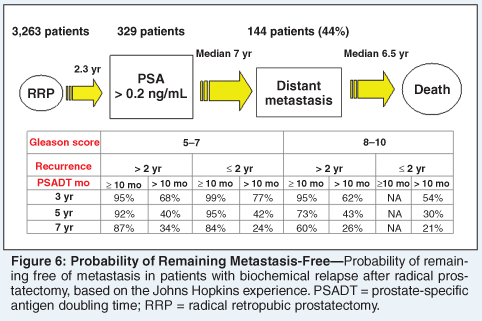
Freedland et al[19] subsequently reported the factors that predict for prostate cancer-specific mortality (PCSM), based on additional follow-up and clinical events in the same group of patients (Figure 7). Factors that best predict for the probability of metastasis and PCSM in both reports are the Gleason score (> 7 indicates a greater risk of developing metastasis), time of PSA relapse (2-3 years after surgery indicates a greater risk of metastasis or PCSM), and PSA doubling time (PSADT, see Figure 7 for the Kaplan-Meier distribution of PCSM in various subgroups).
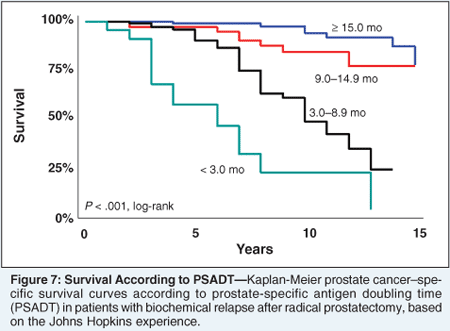
The data reported by Pound et al,[18] as shown in the table in Figure 6, provide an excellent tool that allows physicians and patients to evaluate the probability of developing metastasis. The table illustrates the spectrum of outcome of these patients. On one end of the spectrum, if a patient has a Gleason score < 8, has relapsed more than 2 years after surgery, and has a PSADT longer than 10 months, he has a 95%, 92%, and 87% probability of remaining free of metastasis at 3, 5, and 7 years. In contrast, if a patient has a Gleason score > 7, has relapsed before 2 years after surgery, and has a PSADT of less than 10 months, the probability of remaining free of metastasis at 3, 5, and 7 years is only 54%, 30%, and 21%, respectively. Clearly, the management of the latter patient will differ from that of the former with regard to the aggressiveness of the initial approach. Similar data have been subsequently reported by other investigators.
PSA Doubling Time
The observations in this group of patients suggest that PSADT represents one of the most important parameters for predicting outcome. Subsequent studies have stressed the importance of PSADT as an outcome measure in various subsets ranging from patients with biochemical relapses post-radiation therapy to patients with HRPC. Additional studies focusing on the clinical applicability of PSADT as a prognostic factor, marker for therapeutic efficacy, and surrogate for survival are in progress.
The data on PSADT reported by D'Amico et al[20] and subsequently by Freedland et al[19] have further implications. The survival of patients with a PSADT of 3 months or less (around 6-7 years) is similar to the survival observed in patients with early evidence of metastatic disease (6.5 years in the Johns Hopkins series).[18,19] This suggests that patients with a very rapid PSADT after surgery or radiation therapy have significant subclinical metastatic disease and probably should be treated in the same manner as those with clinical evidence of metastasis. The proportion of patients presenting initially with stage D2 disease has decreased substantially over the past few years, from about 20% to less than 10% of all cases diagnosed in the United States. It is likely that the "stage D2 patient of the PSA era" presents with a rising PSA and no metastasis on scans but with a PSADT of 3 months or less. This subset of patients has been the focus of recent studies evaluating chemotherapy in addition to hormonal therapy.
Nonmetastatic Androgen-Independent Disease
As a result of the frequent practice of initiating androgen deprivation in patients with biochemical relapse prior to the development of bone metastasis, an increasing number of patients demonstrate evidence of a second biochemical relapse but still without clinical evidence of metastasis. These patients, classified as having nonmetastatic androgen-independent disease, represent an even greater enigma for clinicians and clinical trialists.
The natural history of nonmetastatic androgen-independent disease is the focus of major interest for the development of second-line endocrine approaches as well as nonhormonal modalities. Among the treatments developed recently for these patients are bone-targeted approaches such as bisphosphonates, the endothelin antagonist atrasentan (Xinlay), and standard cytotoxic chemotherapy such as docetaxel. However, the natural history of disease in this setting remains poorly defined, and the data reported thus far from retrospective database evaluations and prospective randomized clinical trials indicate a very broad spectrum of time to bone scan progression and median survival. As in the hormone-naive, nonmetastatic paradigm, the PSA dynamics and actual PSA levels are important predictors of outcome.[21]
A recent Eastern Cooperative Oncology Group study (ECOG 1899) comparing a docetaxel-based regimen vs a commonly used second-line endocrine approach (ketoconazole plus hydrocortisone) was prematurely closed due to slow accrual (M. Carducci, personal communication, 2005). Given the rapidly increasing incidence of nonmetastatic androgen-independent disease in the clinic and the need to establish appropriate standards of care (including the use of novel treatment modalities such as bone-targeted approaches or antimetastatic therapies), it is likely that this new paradigm will be the focus of clinical trials in the near future.
Multidisciplinary Programs
As in other common tumor types, multidisciplinary programs have been developed, aiming at the management of patients at high risk for developing distant metastasis and dying of prostate cancer after local treatment. For example, combined-modality treatment with androgen deprivation and radiation has been successfully tested over the past 2 decades in patients receiving radiation therapy for local treatment. A succession of studies evaluating neoadjuvant and adjuvant androgen deprivation were conducted by the Radiation Therapy Oncology Group (RTOG). These studies, some initiated prior to the introduction of PSA, have provided critical data on the role of early androgen deprivation, the interaction of radiation and hormonal therapy, and potential studies with chemotherapy. In fact, RTOG studies combining androgen-deprivation therapy and radiation have helped establish a new standard for patients with palpable tumors in whom radiation represented the primary modality of local treatment.
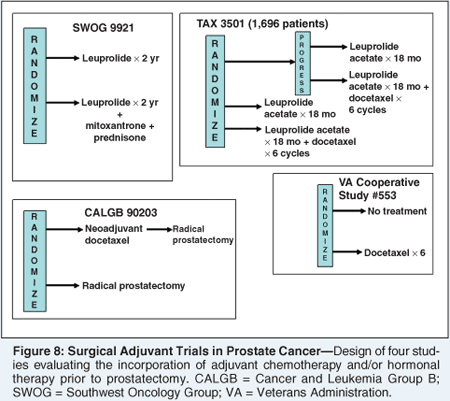
Unfortunately, surgical adjuvant studies have not been nearly as productive as the RTOG experience. However, the recent developments with chemotherapy in HRPC and the availability of newer treatments may soon change this picture. Indeed, as shown in Figures 8 and 9, combined-modality studies in patients with early prostate cancer remain active areas of clinical research, including surgical adjuvant trials. Among such studies is the recently activated global study (TAX 3501), which evaluates the benefits of immediate vs deferred (at the time of progression) treatment with hormonal therapy with or without six cycles of docetaxel in patients with poor clinical and pathologic risk features after radical prostatectomy (Figure 8). This critical study will include a tissue and blood repository to allow for correlative studies of conventional clinical parameters with molecular and other tissue markers that should undoubtedly enhance our understanding of the biology of the disease and identify possible targets for future treatment regimens.

New Systemic Approaches
The recent demonstration of activity of docetaxel in HRPC has generated a great deal of interest in docetaxel combinations with several standard chemotherapy agents and other compounds. Docetaxel combinations represent the most common strategy for new drug development in HRPC at this time. Bone-targeted approaches administered as single agents or in combination include bisphosphonates, radiopharmaceuticals (alone or combined with docetaxel), monoclonal antibodies against cytokines, receptor activator of NFâkappaB ligand (RANKL), and endothelin antagonists. Given the prevalence of bone metastasis in prostate cancer (frequently as the only metastatic site) and in view of the bone effects of long-term androgen-deprivation therapy (which may actually enhance the development of osseous metastasis), bone-targeted approaches are a logical development in this disease. Further study of the biologic and molecular mechanisms of bone metastasis in prostate cancer will undoubtedly generate important advances in the systemic multimodal management of this disease.
Increasing knowledge about the biologic events involved in the growth and differentiation of cancer has resulted in a number of compounds targeted at specific molecular pathways. In prostate cancer, a target that has been the focus of major interest is the androgen receptor. Current data suggest that the androgen receptor may play an important role in disease progression outside of the traditionally understood endocrine pathway. Androgen-receptor signaling remains in effect, through a variety of complex ligand-independent mechanisms, even after conventional hormonally based mechanisms cease to operate.
Other targeted treatments include inhibitors of receptor tyrosine kinase (imatinib mesylate [Gleevec], gefitinib [Iressa], lapatinib [Tykerb]),[22,23] proteasome (bortezomib [Velcade]),[24] endothelin-1 (atrasentan),[25,26] angiogenesis (thalidomide [Thalomid], lenalidomide [Revlimid], bevacizumab [Avastin]),[27,28] and platelet-derived growth factor receptor (imatinib).[22] In addition, investigational agents in active development include those targeting pathways such as Akt/PI3 kinase/mTOR (CCI-779, RAD001), monoclonal antibodies to prostate-specific membrane antigen (MLN-2704), and a variety of immunotherapies such as GVAX,[29] Provenge, Prostvac-VF, recombinant pox viral PSA vaccine, BLP25 MUC1 liposomal vaccine, and anti-CTL4 monoclonal antibody.
Conclusions
We have briefly described how clinical research in prostate cancer has evolved over the past 20 years. Figure 9 provides the reader with a global view of the various paradigms that are the focus of clinical trials, both current and in development. Approximately 85% of patients with prostate cancer today present initially with no evidence of metastasis. The design and implementation of clinical trials in this group is complex and unique, especially in view of the long natural history of the disease.
Exciting new treatments aimed at cellular (androgen receptor) or clinical (bone) targets could possibly result in significant advances in the near future. The recent demonstration that prostate cancer is as responsive to chemotherapy as other diseases considered relatively chemosensitive provided the necessary impetus for the design of adjuvant trials and combined approaches for early disease. Extending the spectrum of clinical research outside of the HRPC paradigm is likely to be more consequential, leading to further decreases in disease-related morbidity and prolongation of prostate cancer-specific survival.
Disclosures:
Dr. Eisenberger is a speaker and advisor for Sanofi-Aventis; and has received grants from Sanofi-Aventis, Cytogene, and Celgene.
References:
1. Eisenberger MA, Simon R, O'Dwyer PJ, et al: A reevaluation of nonhormonal cytotoxic chemotherapy in the treatment of prostatic carcinoma. J Clin Oncol 3:827-841, 1985.
2. Slack N, Mittleman A, Brady MF, et al: The importance of the stable category for chemotherapy treated patients with advanced and relapsed prostate cancer. Cancer 46:2393-2402, 1980.
3. Scott WW, Gibbons RP, Johnson DE, et al: The continued evaluation of the effects of chemotherapy in patients with advanced carcinoma of the prostate. J Urol 116:211-213, 1976.
4. Murphy GP, Gibbons RP, Johnson DE, et al: A comparison of estramustine phosphate and streptozotocin in patients with advanced carcinoma of the prostate. J Urol 118:288-291, 1977.
5. Tannock I, DeWit R, Berry W et al: Docetaxel plus prednisone or mitoxantrone plus prednisone for advance prostate cancer. N Engl J Med 351:1502-1512, 2004.
6. Petrylak DP, Tangen CM, Hussain MHA, et al: Docetaxel and estramustine compared with mitoxantrone and prednisone for advanced refractory prostate cancer. N Engl J Med 351:1513-1520, 2004.
7. Bubley GJ, Carducci M, Dahut W, et al: Eligibility and response guidelines for phase II clinical trials in androgen independent prostate cancer : Recommendations from the Prostate Specific Antigen Working Group. J Clin Oncol 17:3461-3467, 1999.
8. Roessner M, de Wit R,Tannock IF, et al: Prostate-specific antigen (PSA) response as a surrogate endpoint for overall survival (OS): Analysis of the TAX 327 study comparing docetaxel plus prednisone with mitoxantrone plus prednisone in advanced prostate cancer (abstract 4554). J Clin Oncol 23(16S):391s, 2005.
9. Petrylak DP, Ankerst DP, Jiang CS, et al: Evaluation of prostate-specific antigen declines for surrogacy in patients treated on SWOG 99-16. J Natl Cancer Inst 98:516-521, 2006.
10. Berthold DR, Pond G, de Wit R, et al: Association of pain and quality of life response with PSA response and survival of patients with metastatic hormone-refractory prostate cancer treated with docetaxel or mitoxantrone on TAX 327 (abstract 140). Proceedings of the 2006 ASCO Prostate Cancer Symposium, p 162.
11. Tannock I, Osoba D, Stockler MR, et al: Chemotherapy with mitoxantrone plus prednisone or prednisone alone for symptomatic hormone-resistant prostate cancer: A Canadian randomized trial with palliative end points. J Clin Oncol 14:1753-1755, 1996.
12. Eisenberger M, Reyno L, Sinibaldi V, et al: The experience with suramin in advanced prostate cancer. Cancer 75(suppl):1927-1934, 1995.
13. Myers C, Cooper M, Stein C, et al: Suramin: A novel growth factor antagonist with activity in hormone refractory prostate cancer. J Clin Oncol 10:881-889, 1992.
14. Small EJ, Meyer M, Marshall ME, et al: Suramin therapy for patients with symptomatic hormone-refractory prostate cancer: Results of a randomized phase III trial comparing suramin plus hydrocortisone to placebo plus hydrocortisone. J Clin Oncol 18:1440-1450, 2000.
15. Iversen P, Rasmussen F, Asmussen C, et al: Estramustine phosphate versus placebo as second line treatment after orchiectomy in patients with metastatic prostate cancer: DAPROCA study 9002. Danish Prostatic Cancer Group. J Urol 157:929-934, 1997.
16. Hudes G, Greenberg R, Krigel R: Phase-II study of estramustine and vinblastine, two microtubule inhibitors, in hormone-refractory prostate cancer. J Clin Oncol 10:1754-1761, 1992.
17. Hartley-Asp B: Estramustine-induced mitotic arrest in two human prostatic carcinoma cell lines DU 145 and PC-3. Prostate 5:93-96, 1984.
18. Pound CR, Partin AW, Eisenberger MA, et al: Natural history of progression after PSA elevation following radical prostatectomy. JAMA 281:1591-1597, 1999.
19. Freedland SJ, Humphreys EB, Mangold LA, et al: Risk of prostate cancer-specific mortality following biochemical recurrence after radical prostatectomy. JAMA 294:433-439, 2005.
20. D'Amico AV, Moul JW, Carroll PR, et al: Surrogate end point for prostate cancer-specific mortality after radical prostatectomy or radiation therapy. J Natl Cancer Inst 95:1376-1383, 2003.
21. Smith MR, Eastham J, Gleason DM, et al: Randomized controlled trial of zoledronic acid to prevent bone loss in men receiving androgen deprivation therapy for nonmetastatic prostate cancer. J Urol 169:2008-2012, 2003.
22. Chatta GS, Fakih M, Ramalingam S, et al: Phase I pharmacokinetic study of daily imatinib in combination with docetaxel for patients with advanced solid tumors (abstract 2047). Proc Am Soc Clin Oncol 23:138, 2004.
23. Schröder FH, Wildhagen MF: ZD1839 (gefitinib) and hormone resistant prostate cancer-final results of a double blind randomized placebo-controlled phase II study (abstract 4698). J Clin Oncol 22(14S), 2004.
24. Papandreou CN, Daliani DD, Nix D, et al: Phase I trial of the proteasome inhibitor bortezomib in patients with advanced solid tumors with observations in androgen-independent prostate cancer. J Clin Oncol 22:2108-2121, 2004.
25. Carducci MA, Nelson JB, Bowling K, et al: Atrasentan, an endothelin-receptor antagonist for refractory adenocarcinomas: Safety and pharmacokinetics. J Clin Oncol 20:2171-2180, 2002.
26. Carducci MA, Padley RJ, Bruel J, et al: Effect of endothelin-A receptor blockade with atrasentan on tumor progression in men with hormone-refractory prostate cancer: A randomized, phase II, placebo-controlled trial. J Clin Oncol 21:679-689, 2003.
27. Dahut WL, Gulley JL, Arlen PM, et al: Randomized phase II trial of docetaxel plus thalidomide in androgen-independent prostate cancer. J Clin Oncol 22:2532-2539, 2004.
28. Picus J, Halabi S, Rini B, et al: The use of bevacizumab with docetaxel and estramustine in hormone refractory prostate cancer: Initial results of CALGB 90006 (abstract 1578). Proc Am Soc Clin Oncol 22:393, 2003.
29. Simons J, Nelson W, Nemunaitis J, et al: Phase II trials of a GM-CSF gene-transduced prostate cancer cell line vaccine (GVAX) in hormone refractory prostate cancer (abstract 729). Proc Am Soc Clin Oncol 21:183a, 2002.
30. Fong L, Rini B, Kavanaugh B, et al: CTLA-4 blockade-based immunotherapy for prostate cancer (abstract 2590). Proc Am Soc Clin Oncol 23:185, 2004.
31. Tannock I, Osoba D, Stockler M, et al: Chemotherapy with mitoxantrone plus prednisone or prednisone alone for symptomatic hormone-resistant prostate cancer: A Canadian randomized trial with palliative end points. J Clin Oncol 14:1756-1764, 1996.
32. Kantoff PW, Halabi S, Conaway M, et al: Hydrocortisone with or without mitoxantrone in men with hormone-refractory prostate cancer: Results of the Cancer and Leukemia Group B 9182 study. J Clin Oncol 17:2506-2513, 1999.
33. Beer TM, Ryan CW, Venner PM, et al: Interim results from ASCENT: A double-blinded randomized study of DN-101 (high-dose calcitriol) plus docetaxel vs placebo plus docetaxel in androgen independent prostate cancer (abstract 4516). J Clin Oncol 23(16S):382s, 2005.
Newsletter
Stay up to date on recent advances in the multidisciplinary approach to cancer.
Navigating Treatment Intensification in Metastatic Hormone-Sensitive Prostate Cancer
A patient case of a 50-year-old man with hormone-sensitive prostate cancer sparked a debate among oncologists regarding the best course of action.